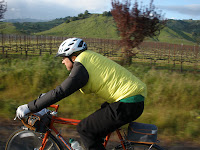 California has an extensive calendar of double century rides, and it was the double century that first lured me into long distance riding. Doing my first Davis Double Century in 2000, I was thrilled to be riding amongst hundreds of other riders. I still do several doubles a year now, but in 2002 many of my friends were 'graduating' to even longer rides. In 2003, these friends nearly disappeared from club rides with modest 100 mile distances. They were off riding something called 'brevets', basically qualifiers for a ride in Europe called Paris, Brest et retour. This cycling niche was known as randonneuring, based on the french word randonneur (the masculine form of the word for someone that commonly engages in hiking, but applied to cycling in a specific manner). By August, those friends had disappeared completely. They were all off in France doing a single ride of 770 miles, hopefully within the 90 hour time limit. All fall and into winter I heard countless stories of the PBP experience, and I was completely intrigued. In 2004, I decided to test myself as well when I signed up for a rather unique version of randonneuring known as a Flèche.
California has an extensive calendar of double century rides, and it was the double century that first lured me into long distance riding. Doing my first Davis Double Century in 2000, I was thrilled to be riding amongst hundreds of other riders. I still do several doubles a year now, but in 2002 many of my friends were 'graduating' to even longer rides. In 2003, these friends nearly disappeared from club rides with modest 100 mile distances. They were off riding something called 'brevets', basically qualifiers for a ride in Europe called Paris, Brest et retour. This cycling niche was known as randonneuring, based on the french word randonneur (the masculine form of the word for someone that commonly engages in hiking, but applied to cycling in a specific manner). By August, those friends had disappeared completely. They were all off in France doing a single ride of 770 miles, hopefully within the 90 hour time limit. All fall and into winter I heard countless stories of the PBP experience, and I was completely intrigued. In 2004, I decided to test myself as well when I signed up for a rather unique version of randonneuring known as a Flèche.
Flèche is the french word for arrow, and this choice of word to name the event comes into play if you imagine a target, with arrows flying toward the bulls-eye from all directions. The arrows represent the individual routes each Flèche team submits to the organizers, and the target is a central location with a specific meeting time where all the teams end up. The path the arrow follows in this case needs to be at least 360km, and the time of the 'flight' is no more than 24 hours and no less than 23 hours. The whole endeavor is said to derive from the efforts of several friends who on Easter weekend would travel the distance between Paris and St. Etienne, roughly 360 km, in order to meet up with other friends where they would share an Easter breakfast. The current organization of the Flèche has teams made up of riders on between three and five bicycles, and at least three team members need to finish the distance for the team to get credit for completing the ride. The team aspect is of course enormous, and plays heavily in guiding the make up of teams. At minimum, at least one team member knows all the other riders and more commonly, all team members are well acquainted. After all, the team will spend 24 hours in close company as they ride across the day and through the night aiming toward the finish target.

On April 3rd, my team, known as Obio's dog, left Berkeley, California at 07:15 and over the next 24 hours we would travel through Hercules, Vallejo, Rockville, Fairfield, pass west of Winters and then head toward St. Helena, Calistoga, Healdsburg, Santa Rosa, Petaluma, Nicasio, Fairfax, Corte Madero, Sausalito, finally stopping at Crepes on Cole, south of the panhandle portion of Golden Gate Park in San Francisco. Our route was 233 miles long, gaining over 10,000' in elevation along the way. When we began, skies were overcast and temperatures were in the mid 40sF. By mid afternoon we had found sunny skies and sunshine fueled warmth had found us. Through the night, haze nearly obscured the moon and stars and temperatures slid into the upper 30s F, but the cold temps were offset by the disappearance of headwinds, a fair enough trade in my book.

Comments